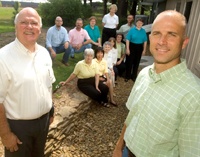Stitt Builds on Passion for Sustainability
by July 13, 2009 12:00 am 103 views

When Orlo Stitt founded Stitt Energy Systems Inc. in 1978 to promote energy efficient design, he was met with skepticism. Building green homes was not yet a popular concept.
More than 30 years later, the company has designed and built energy efficient homes in more than 15 states. It has won 19 National Energy Value Housing Awards and the National Home Builders Association’s Green Building Award.
Orlo and his son, David Stitt, who is also vice-president of the company, remain focused on their goal of helping people save on energy costs while building environmentally responsible homes.
“I think the biggest thing is our commitment,” Orlo said. “We’re not just talking about it, we’re doing it.”
The company’s own corporate office, on South 8th Street in Rogers, is an example of their commitment.
In 2007, the Stitts realized they needed more space to meet the needs of the growing company. Rather than purchase property for new construction, the company chose to expand and update its current location near downtown Rogers.
The Stitts broke ground on the expansion in 2008, saving more than 75 percent of the existing structure, which was built in 1946. Doing this meant about 85 percent of construction waste was diverted from the landfill through sorting and recycling of deconstruction debris and careful use of new construction materials.
Stitt’s office building was renovated with solar panels on the roof. Passive solar design was used, allowing natural light to come in. The design provides natural heating during the winter months, while blocking the sun’s heat during summer months.
LED lights controlled by motion sensors were installed as well as low-flow water fixtures with sensors.
Operable skylights and windows were included to provide natural flow-through ventilation and daylight.
Translucent window shades save energy and allow the occupants to control the amount of light in their workstations.
Two septic systems keep all wastewater on site without adding additional burden to the municipal sewer system.
Natural landscaping reduces water usage by taking advantage of native plants and grasses that don’t require as much water or mowing.
The new facility is a LEED-registered project. Stitt is expecting a platinum rating, the highest possible LEED certification.
But the company’s green culture is about more than the physical components of the building.
Employees are healthier and more productive because their workspace is cleaner and more enjoyable, the Stitts said.
Each workstation has a window with a view to the outside. A heat recovery ventilator exhausts stale air and pumps pre-conditioned fresh air into the building. There is no smoking permitted on the site.
The Stitts said they’ve already noticed a difference in employee health. One employee who was chronically ill with colds and asthma has not missed a day of work since the company moved into the building in February.
“The concept of green to us means lower costs and happier employees, which translates to better work and higher sales,” David said. “I don’t know that there is any downside to this.”
Stitt’s employees have willingly adopted the company’s green ideals. They take pride in working in an environmentally-friendly office, Stitt said. One hundred percent of them recycle office waste.
In addition to four hybrid vehicles driven for business purposes, two other employees drive hybrids to and from work.
There is a compost bin on-site with the compost used as mulch on the property.
About 50 percent of the employees bring their lunch to work.
The company also encourages employees to bike to work by offering bicycle racks and a shower at the office.
David said many of the employees have taken some of the green office culture into their personal lives. They recycle at home and use compost bins. One employee is doing her yard with natural landscaping and another employee is remodeling his home to include energy efficient appliances.
“It’s contagious,” David said. “Everyone wants to save money, so they’re bound to take some of this knowledge home with them.”
Stitt takes the same approach used in the construction of its office in the construction of homes for their customers.
When designing and building a home, the company first visits the site to determine the best location and orientation of the home, using the trees for summer shading and the sun for natural winter warmth.
Sustainable and energy-efficient materials and techniques are used in the home, including:
- Insulated concrete forms for the foundations
- Pre-engineered floor and roof trusses
- Pre-engineered wall panels
- Pre-engineered structural materials
- Borate-based termite control products
- Soy-based foam insulation
- Fiber-cement sidings with recycled content
- Low- or no-VOC paints and finishes
- Recycled flooring, cabinetry and countertops
- Energy Star appliances
- Energy efficient heating and cooling systems
- Low-flow plumbing fixtures
- On-demand hot water systems
Each home is inspected twice for energy efficiency and then rated by a third-party, certified home energy rater.
